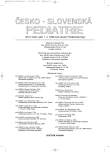Plasmapheresis and Immunoadsorption in Pediatrics
Authors:
F. Fencl; T. Seeman; E. Šimková; J. Janda
Authors‘ workplace:
Pediatrická klinika UK 2. LF a FN Motol, Praha
přednosta prof. MUDr. J. Lebl, CSc.
Published in:
Čes-slov Pediat 2008; 63 (3): 148-155.
Category:
Review
Overview
The article deals with plasmapheresis and immunoadsorption at the child age. It describes the indications, contraindications, untoward effects and technical aspects of the methods and offers evaluation of more recent, selective and patient-friendly immunoadsorption as compared with classical plasmapheresis. Whereas plasmapheresis is an already established method, immunoadsorption represents a therapeutic possibility, which is relatively new for pediatrics and its use has been continuously given increasing precision.
At the present time the main indications of immunoadsorption include the group of autoimmune diseases and diseases with presumed immunological etiological participation (for example dilatation cardiomyopathy, hemophilia with inhibitors, thrombotic thrombocytopenic purpura, rheumatoid arthritis), metabolic diseases (LDL apheresis in familial hypercholesterolemia) and the application in transplantology (for instance organ transplantation with HLA hyperimmunization, and reaction of the graft against the host).
Key words:
plasmapheresis, immunoadsorption, children
Sources
1. Wayne AS, Fosburg MT. Therapeutic plasma exchange and cytapheresis. In Nathan DG, Oski FA. Hematology of Infancy and Childhood. 4th ed. Mexico: W. B. Saunders Comp., 1993: 1819–1830.
2. McLeod BC. Introduction to the this special issue: Clinical application of therapeutic apheresis. J. Clin. Apheresis 2000;15: 1–5.
3. Avner ED, Harmon WE, Niaudet P. Pediatric Nephrology. 5th ed. Philadelphia: LW&W, 2004.
4. Bosch T, et. al. Extracorporeal plasma treatment in primary and recurrent focal segmental glomerular sclerosis: a review. Ther. Apher. 2001;5(3): 155–160.
5. Bunchman TE. Plasmapheresis and renal replacement therapy in children. Curr. Opin. Pediatr. 2002;14(3): 310–314.
6. Madore F. Plasmapheresis. Technical aspects and indications. Crit. Care Clin. 2002;18(2): 375–392.
7. Smith JW. Therapeutic apheresis in the United States: Current indication and direction. Ther. Apher. 1999;3: 1–3.
8. Hladík M. Volba eliminační metody v intenzivní péči. In Fedor M, Minarik M, Kunovský P, et. al. Intenzivní péče v pediatrii. Martin: Osveta, 2006: 270–282.
9. Kreisinger J, Šimková E, Feber J, et al. Plazmaferéza u dětí – indikace, technika, výsledky. Čes.-slov. Pediat. 1999;54(8): příloha VI.
10. Pineda A. Selective therapeutic extraction of plasma constituents, revisited. Transfusion 1999;39: 671–673.
11. Pták J. Imunoadsorpce – nová možnost léčby autoimunitních onemocnění. Prakt. Lék. 2002;82(6): 336–339.
12. Agishi T. The current status of extracorporeal immunomodulation. Transfus. Sci. 1996;17: 439–444.
13. Borberg H, Jimenez C, Belák M, et al. Treatment of autoimmune disease by immunomodulation through extracorporeal elimination and intravenous immunoglobulin. Transfus. Sci. 1994;15: 409–418.
14. Dau PC. The fundamental basis for therapeutic plasmapheresis in autoimmune diseases. Transfus. Sci. 1996;17: 235–244.
15. Brunkhorst R. Clinical immunoadsorption, Hannover, Germany, February 28th – March 1st, 1997. Nefrol. Dial. Transplant. 1998;13: 222–224.
16. Gjorstrup P, Watt RM. Therapeutic protein A immunoadsorption. A review. Transfus. Sci. 1990;11: 281–302.
17. Jones FR, Balint JP, Snyder HW. Selective extracorporeal removal of immunoglobulin-G and circulating immune complexes: a review. Plasma Ther. Transfus. Technol. 1986;7: 333–349.
18. Toepfer M, Sitter T, Burchardi C, et al. Klinische Immunoadsorption. Dtsch. med. Wschr. 1999;124: 461–465.
19. Takamori M, Ide Y. Specific removal of antiacetylcholine receptor antibodies in patients with myasthenia gravis. Transfus. Sci. 1996;17: 445–453.
20. Belák M, Borberg H, Jimenez C, et al. Technical and clinical experience with protein A immunoadsorption columns. Transfus. Sci. 1994;15: 419–422.
21. Matic G, Hofmann D, Winkler R, et al. Removal of immunoglobulin by a protein A versus an antihuman immunoglobulin G-based system: Evaluation of 602 sessions of extracorporeal immunoadsorption. Artificial Organs 2000;24: 103–107.
22. Moriconi L, et al. Proteinuria in FSGS: role of circulating factors and therapeutic approach. Ren. Fail. 2001;23(3–4): 533–541.
23. Moriconi L, et al. Apheresis in primary focal segmental glomerulosclerosis of native and transplanted kidneys: a therapeutic protocol. J. Nephrol. 2000;13(5): 347–351.
24. Muller J, Wallukat C, Dandel M, et al. Immunoglobulin adsorption in patients with idiopathic dilated cardiomyopathy. Circulation 2000;101: 385–391.
25. Nilsson IM, Berntorp E, Freiburghaus Ch. Treatment of patients with factor VIII and IX inhibitor. Thrombosis and Hemostasis 1993;70: 56–59.
26. Savin VJ, et al. Permeability factors in focal segmental glomerulosclerosis. Semin. Nephrol. 2003;23(2): 147–160.
27. Braun N, Kadar JG, Risler T. Therapeutic immunoadsorption – its role in clinical practice. Transfus. Sci. 1998;19(Suppl): 65–69.
28. Fencl J, Janda J, Seeman T, et al. Recurrence of nephrotic proteinuria in children with focal segmental glomerulosclerosis after renal transplantation treated with plasmapheresis and imunoadsorption: case reports. Transplant. Proc. 2007; Dec 39(10): 3488–3490.
29. Schneider KM. Plasmapheresis and immunoadsorption: Different techniques and their current role in medical therapy. Kidney Int. 1998;53(Suppl. 64): S61–S65.
Labels
Neonatology Paediatrics General practitioner for children and adolescentsArticle was published in
Czech-Slovak Pediatrics

2008 Issue 3
Most read in this issue
- Tularaemia: Rare Cause of Fever and Lymphadenopathy in an Infant
- Plasmapheresis and Immunoadsorption in Pediatrics
- Czech Atherosclerosis Society Guidelines for the Diagnosis and Treatment of Dyslipidemias in Children
- Kawasaki Disease (40th Anniversary of the First Publication)
